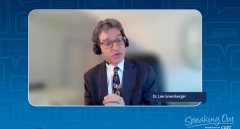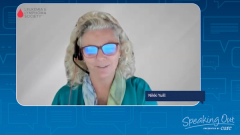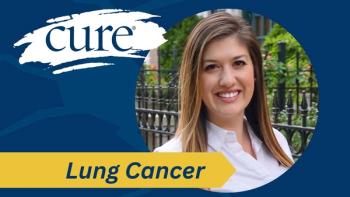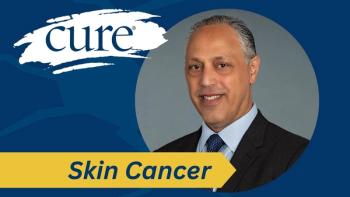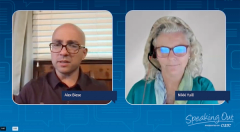
What treatments for leukemia and lymphoma are on the way?

As part of its Speaking Out video series, CURE spoke with Dr. Lee Greenberger, chief scientific officer of the Leukemia & Lymphoma Society, about the current research in treatments.
Episodes in this series

Transcription: Hi, my name is Alex Biese. I'm the assistant managing editor of CURE magazine, and in this edition of the Speaking Out video series, on behalf of the Leukemia & Lymphoma Society, we're speaking with chief scientific officer Dr. Lee Greenberger about the current research in that field. Dr. Greenberger, thank you so much for joining me today.
Greenberger: My pleasure.
Biese: So, what are the priorities in the current research environment?
Greenberger: So, the Leukemia and Lymphoma Society has been in the business of funding research and therapeutics for literally 70 years, and in the last really 10 to 20 years much of our $1.5 billion that we've spent in research has been deployed really, in the last 10 years. We've done this because the translation of basic research to new therapies has really emerged dramatically. And this speaks to the 15 to 20 FDA approvals consistently every year for about the last five years, as opposed to five to 15 years ago, where we were seeing two to three approvals a year.
The priorities for the current research environment, in some ways still remain the same as it's been even for the many decades before: understand the disease, identify what the drivers are for the disease, develop therapies to those targets, moving into clinical trials as rapidly as possible, find out which patients are responsive to the therapies and perhaps even more importantly, which patients are not responsive to the therapies. And so this has been the basic method of cancer drug development really, for the last 50 years. The difference is, and the reason why things are going so much faster, is one, immunotherapy has definitely moved to the top. Now we know that if the immune system can be activated properly, it can kill tumor cells, and in some cases, achieve cures in patients. And there is a whole variety of ways to activate the immune system that have translated into therapies. We also know that the immune system is incredibly complex and that the basis for a successful treatment or a failed treatment sometimes resides in understanding what the immune system is doing. The immune system has, for example, a lot of levers that can activate the immune system or deactivate the immune system. And so once you understand all of these levers, and let's say they're about — it's not simply one or two, it's more like about 20 — and what the immune system is doing in the environment of the tumor and how it actually can activate or deactivate cells, immune cells that can kill the tumor, is critically important. And that's basically a new area that has really come to light to really understand the immune system.
It's not only simply just understand(ing) the immune system, but it's also understanding how even diet, lifestyle, whether you're obese or not obese, can regulate the immune system. And I think that that's going to become more important in the next five or 10 years. We can see the research moving in the right direction, saying this is important. We see correlations and (what) looks like cause and effect. And once you know that, then you can begin to say, 'Well, what's the proper diet?' Or, 'What are the ingredients to control this that may influence the immune system to improve outcomes?'
We're also beginning to have a concept of prevention in blood cancers. Now, if you told me 10 years ago prevention of blood cancers would be possible I would say, 'Well, not really.' But now it's pretty clear, by the analysis of the mutations that occur in cancer, we can see these mutations occurring early in patients, even before they have blood cancers, myeloma, CLL, diffuse large B-cell lymphoma, we can see this mutations appearing even before the patient has blood cancer. That tells us that patient could be at risk. And then the question is, 'Well, once you know the mutation is there, can you prevent that patient (from) converting over to full-blown blood cancer?' And of course, the underlying hypothesis is if you treat early, even before you have a full-blown cancer, you'll have a better result. And if we eliminate in the preventative stage that you won't even develop cancer. And beyond that, are there therapeutics that we can that we can develop to treat patients safely? Because if you're going to treat in the prevention mode, you certainly don't want a lot of side effects. None at all. It's sort of like taking Lipitor to control cardiovascular disease, is there a Lipitor equivalent for prevention of blood cancers?
But just being able to identify patients early on, maybe even 10 years before they even convert over to blood cancers, and who is at high probability of converting over, is an emerging area for study.
And finally, I have two other items. One is, of course, precision medicine. Gleevec is the paramount precision medicine to treat chronic myeloid leukemia, and it's curative. You take that oral medication, and it can be curative for CML. We know this. That drug's been on the market for probably over 20 years now. What are the other targets where there are mutations in cancers that they are the main drivers such that if we develop therapeutics to target that mutation, we'll get a very good response, and we'll get cures? So there are still new targets emerging for precision medicine.
Of course, in AML, acute myeloid leukemia, which is so difficult to treat, there are multiple mutations. And the question is, 'Which mutation does the patient have? And can we treat with either one drug or more likely a cocktail of drugs, to to control and get rid of AML?' And finally, now that we have all these therapeutics, what kind of quality of life are patients going to have? What's going to be the cost involved? And how do we deal with diversity, to make sure that every patient has access to these new therapies, and clinical trials?
Biese: And going off that, the questions that still remain, what are some still unmet needs for patients? And are there any thoughts as to why those needs remain unmet?
Greenberger: So clearly, many therapies we have now can control, perhaps even long-term control, chronic lymphocytic leukemia, could public control that for five, maybe 15 years. The drugs are not curative. We could still see by very sophisticated molecular methods, simply sampling the blood are actually taking a biopsy of the tumor, we see that the tumor still there, it's just the number of cells has been reduced.
The problem with blood cancers are those cells that are still there, can come back to haunt you, five to 15 years later. They not only can mutate and change again, but they can also just spontaneously start proliferating, and the cancer will come back. So in terms of unmet needs, cures. What's the road to cures? If you ask a patient with Waldenstrom macroglobulinemia, a fairly rare lymphoma in 1,000 to 1,500 new patients a year, the therapies are available that can control the disease, but they say, 'What's the road to cures?' And we don't exactly know. So that's clearly the unmet need, the road to cures. And how are we going to know that we're there? Simply because well, you took the drug now you're off the drug, we waited 10 years, the disease didn't come from come back? That's a cure. Can we detect cures earlier? Can we develop even diagnostic methods to say, we don't see anything at all, and that's reliable? That's going to be a cure, or at most long-term disease control, you don't have to worry about this anymore. You don't have to worry about taking medications, you don't have to worry about doing co-pays. Can we achieve that? So that's clearly an unmet need. It's on the horizon for many blood cancers. I think in the next five to 15 years, we're gonna get there.
Can we pay for these therapies? Well, we'll have to see. These therapies are expensive. And we're not talking about $5,000 or $10,000 therapies, we're talking about hundreds of thousands of dollars. Some of that the government is going to have to pay, some insurance is going to have to pay, but some of it the patients are going to have to pay as well. And the price tags are going to be significant. How are we going to manage that. So that's clearly an unmet need as we develop all these sophisticated therapies: Who's going to pay for them? And how do we justify the cost? I can tell you that even these therapies, the-so called CAR-T therapies, these immunotherapies, these can cost $400,000 to $500,000 a year. One dose can be curative in a patient who has had multiple relapses. And now what we're seeing is you can use the so-called immunotherapies, these CAR-T therapies, earlier on in patients, perhaps even in high-risk patients as frontline therapy. Can you use a $500,000 therapy as frontline therapy saying, 'This is going to be a cure?' Well, you might be justified in doing that, because if a patient has to go through five or 10 years of therapy, it's going to come out the same result, but (with) a lot of strife along the way, as opposed to a one-time therapy. So, you can see that these expensive therapies might be justified in the right patient, we're gonna have to prove that in the next years head.
Biese: That is fascinating, I think it's going to be a very eventful couple of years based on everything you're letting us know. And what is some other research on the horizon that patients should be aware of and patient should be keeping an eye out for and an ear to the ground for?
Greenberger: Yeah. I basically think it's going to be new immunotherapies, evaluating the immune status in patients, whether that be in the whole body, or in the tumors. If we can visualize or sample or understand what's going on in the immune environment at the site of the tumor, and we can now do this with various sophisticated microscopic molecular techniques, this is going to help us guide what therapy, particularly immunotherapy, is best for patients and why it is working or why it's not working, and tell us when it might not be working so we know when to switch to a new therapy.
I know that in solid tumors and in blood cancers, the way of simply sampling the blood and looking for tumor cells that are floating around in the blood with very precision, highly sensitive molecular methods instead of using radiologic methods, just simply sampling the blood and saying 'The tumor is gone,' or 'The tumor is at risk of coming back, we see it,' and so those non-invasive methods are also another diagnostic tool that's really coming to the forefront and understand how to use these best and how predictive they are, as opposed to the conventional biopsy radiologic imaging methods, which can only be done periodically, whereas a blood sample can be done quite frequently.
Biese: And finally, let's say there are patients that really want to find themselves kind of on the front lines, on the cutting edge of research, what should they know about the process of enrolling in clinical trial?
Greenberger: Right, so I told you that there were many new therapy is approved, such that for a patient who is not familiar with all these drugs, or even listening to a physician or their support staff, it's like a maze. Which therapy do you choose? How do you figure this out? And it's quite difficult, a patient has to be quite sophisticated to figure out what might be best and might even require a second or perhaps even a third opinion. And even then, physicians may have differing opinions (on) what may work best or not.
The Leukemia & Lymphoma Society has a clinical trial service, a navigating service that patients could get access to either by just the website, LLS.org, or clinical trial service support center, CPSC, which is available on our website, can call or go onto our website and speak to a nurse navigator who can say, 'OK, I know what disease you have. I know what stage the diseases and what part of the country you're in. I know what your habitual comorbidities might be. And now we're going to look for trials that you may fit all these parameters that you could join for an appropriate trial.' And our nurse navigators can actually bring you to the door of those sites across the country that are running a trial that might be best-suited for you such that you can have the conversation with those physicians to decide if you're really fit for that clinical trial.
Now, some patients might get standard-of-care and say, 'You know what, you don't need a clinical trial, you should do standard of care.' For example, chronic lymphocytic leukemia patient, first line therapy, call in an oral therapy, the so-called BTK inhibitors, go to your pharmacy, get the prescription, take the drug as prescribed on a daily basis, and it should control the disease for a significant period of time. But for patients who have relapsed disease, or have a very aggressive disease, such like a leukemia, or diffuse large B-cell lymphoma, which can move very rapidly, that's the time to really consult the physician, understand the pathology report, perhaps get a second opinion, speak to our nurse navigators and say, 'What's the best path for you?' It's very difficult for a patient who was facing, saying, 'What?' You heard 'I have cancer' and then it's kind of, 'I didn't hear much of whatever else you told me after that, because you just told me I have cancer.' Those patients need help navigating the system. We can help them do that at the Leukemia & Lymphoma Society.
Biese: That's fantastic, that's a wonderful resource. Doctor, thank you so much for your time and for your insight today, we so appreciate it. Thank you. You have a great day.
Greenberger: Thank you so much. Pleasure
Transcription edited for clarity and conciseness.
For more news on cancer updates, research and education, don’t forget to


